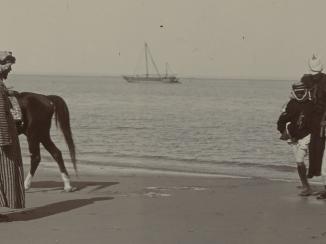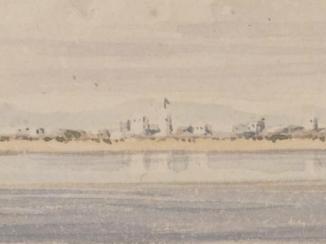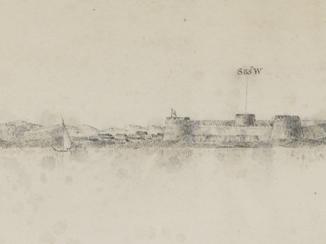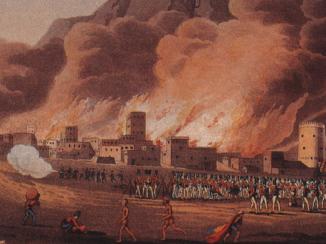'Book 133' Secret letters inward
IOR/R/15/1/97
74 items in this record
Search within this record
The record is made up of 1 file (37 folios). It was created in 27 Dec 1841-15 Dec 1842. It was written in English. The original is part of the British Library: India Office The department of the British Government to which the Government of India reported between 1858 and 1947. The successor to the Court of Directors. Records and Private Papers Documents collected in a private capacity. .
About this record
- Content
The file contains an exchange of letters between British Government officials in India and London, copied to Lieutenant H D Robertson (Officiating British Resident in the Persian Gulf The historical term used to describe the body of water between the Arabian Peninsula and Iran. ) for his information and guidance. The letters often refer to the regular reports submitted by the British Resident in the Persian Gulf The historical term used to describe the body of water between the Arabian Peninsula and Iran. to the Bombay Government and occasionally contain specific instructions or decisions for the Resident to follow.
The main correspondents are: J P Willoughby and L R Reid (Secretaries to the Government of Bombay From c. 1668-1858, the East India Company’s administration in the city of Bombay [Mumbai] and western India. From 1858-1947, a subdivision of the British Raj. It was responsible for British relations with the Gulf and Red Sea regions. , on behalf of the Governor in Council of Bombay) and J H Maddock (Secretary to the Government of India, on behalf of the Governor General of India in Council). Other correspondents include: the Secret Committee Pre-1784, the Committee responsible for protecting East India Company shipping. Post-1784, its main role was to transmit communications between the Board of Control and the Company's Indian governments on matters requiring secrecy. of the Court of Directors The London-based directors of the East India Company who dealt with the daily conduct of the Company's affairs. of the East India Company, mainly communicating the wishes of Lord Aberdeen (British Secretary of State for Foreign Affairs) about the British evacuation of Karrack and Captain Atkins Hamerton (British Agent at Muscat) reporting from Zanzibar about slave trafficking in the East African ports belonging to the Imam of Muscat.
The letters discuss events in the Persian Gulf The historical term used to describe the body of water between the Arabian Peninsula and Iran. in 1842, relations between the rival Arab Maritime Chiefs particularly over slave trafficking, relations between Britain and Persia particularly over the possession of the Island of Karrack [Kharg], the state of the Maritime Peace and several other topics.
British evacuation of the Island of Karrack and its restoration to the Persian Government by treaty, including: removal of the British Residency An office of the East India Company and, later, of the British Raj, established in the provinces and regions considered part of, or under the influence of, British India. from Karrack back to Bushire, British attitude to the eventual replacement of British pilotage charges on Karrack with a Persian system of pilotage dues, retention of a British coal depot on Karrack for the use of East India Company steamers, proposal for the re-occupation of Bassadore [Bāsa‘īdū] as a British naval depot in the Persian Gulf The historical term used to describe the body of water between the Arabian Peninsula and Iran. for the East India Company’s squadron of war ships, proposal to convert the British station on Karrack to an invalid station for Europeans in India (folios 9, 20, 24, 27-29, 31-36).
British suppression of the maritime slave traffic in the Persian Gulf The historical term used to describe the body of water between the Arabian Peninsula and Iran. , including: trading in slaves between the ports of the Persian Gulf The historical term used to describe the body of water between the Arabian Peninsula and Iran. and the Red Sea by members of the Joasmee [Qasimi] Tribe under the authority of the Arab Maritime Chiefs and the inability of the Imam of Muscat to prevent them from visiting the ports of his East African territories, the importation of Soomalee [Somali] slaves into Shargah [Sharjah], the importation of African slaves from Muscat into the territory of the Ameers [Amirs] of Scinde in Pakistan, new stringent measures proposed by the British Resident with regard to financial penalties, seizures and confiscations of all native boats involved in slave trafficking between the East Coast of Africa and the various ports in the Persian Gulf The historical term used to describe the body of water between the Arabian Peninsula and Iran. and Red Sea, the British Government’s long term policy towards the eradication of all trade in slaves between Africa, India and the East African and Arabian countries bordering the Persian Gulf The historical term used to describe the body of water between the Arabian Peninsula and Iran. and the Red Sea (folios 3, 10-13, 15-19).
The renewal of the annual Maritime Truce between Great Britain and the Chiefs of the Arab Ports in the Persian Gulf The historical term used to describe the body of water between the Arabian Peninsula and Iran. and the reasons for and against extending the duration of its term (folios 6, 14); British reaction to an alleged planned invasion of Bahrein [Bahrain] and Koweit [Kuwait] by Persia (folios 29-31) and British relations with Ameer Khaled and his supposed intention to invade Oman (folios 3-7).
The file title ‘Book 131 1832’ is written in blue ink on the file cover, with the year '1832' crossed out in pencil (folio 1). The file contains letters written in 1842 not 1832, and one letter written in 1841 (folios 2-3).
- Extent and format
- 1 file (37 folios)
- Arrangement
The letters are arranged chronologically. Several letters incorporate copied extracts from earlier letters or enclose them separately.
- Physical characteristics
Foliation: numbered 1 to 37, beginning on the front of the file cover and ending on the inside of the back cover. The numbering is written in pencil and encircled, on the recto The front of a sheet of paper or leaf, often abbreviated to 'r'. of each folio, in the top right corner.
The 27 letters in the file were originally numbered in ink, on the recto The front of a sheet of paper or leaf, often abbreviated to 'r'. of every folio, in the topr right corner, as follows: 8-10, 15-18, 36, 47-50, 85, 113-117, 143, 149-151, 155, 158-159, 162, 164, 185-188, 210, 230-232.
- Written in
- English in Latin script
- Type
- Letter book
Archive information for this record
- Original held at
- British Library: India Office The department of the British Government to which the Government of India reported between 1858 and 1947. The successor to the Court of Directors. Records and Private Papers Documents collected in a private capacity.
- Access conditions
Unrestricted
- Archive reference
- IOR/R/15/1/97
- Date(s)
- 27 Dec 1841-15 Dec 1842 (CE, Gregorian)
Access & Reference
History of this record
Related search terms
Use and share this record
- Share this record
- Cite this record in your research
'Book 133' Secret letters inward, British Library: India Office Records and Private Papers, IOR/R/15/1/97, in Qatar Digital Library <https://www.qdl.qa/archive/81055/vdc_100000000193.0x000046> [accessed 16 April 2024]
- Link to this record
https://www.qdl.qa/en/archive/81055/vdc_100000000193.0x000046
- IIIF details
This record has a IIIF manifest available as follows. If you have a compatible viewer you can drag the icon to load it.https://www.qdl.qa/en/iiif/81055/vdc_100000000193.0x000046/manifestOpen in Universal viewerOpen in Mirador viewerMore options for embedding images
Copyright: How to use this content
- Reference
- IOR/R/15/1/97
- Title
- 'Book 133' Secret letters inward
- Pages
- front, front-i, 2r:36v, back-i, back
- Author
- East India Company, the Board of Control, the India Office, or other British Government Department
- Usage terms
- Open Government Licence














































































